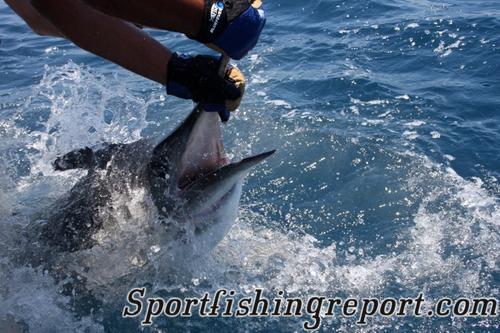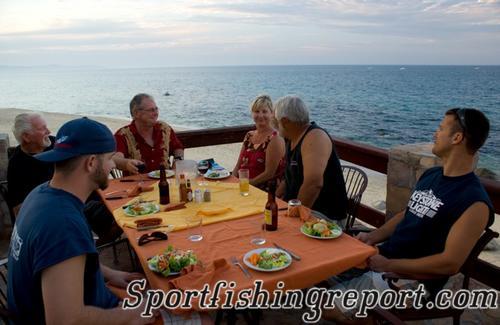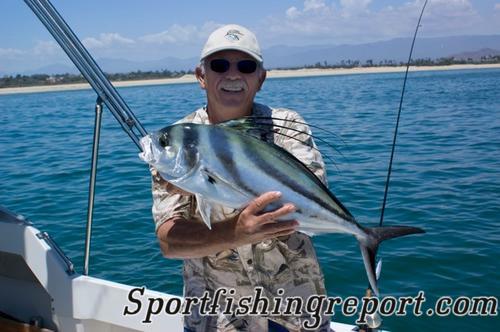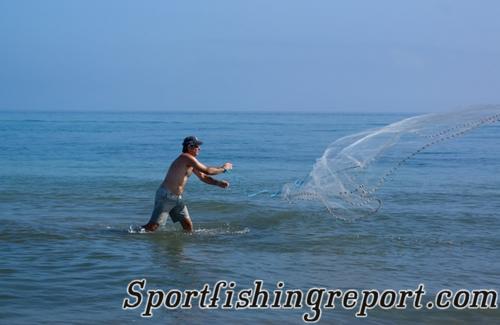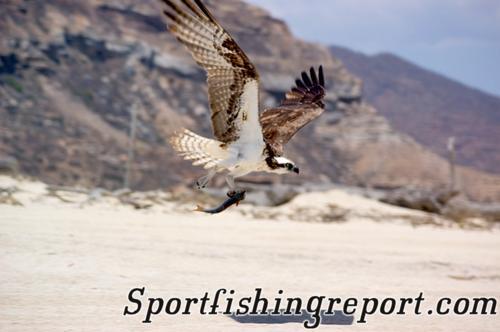Long Range Fish Report
From Sportfishing
From Sportfishing
Fish Report for 5-26-2009
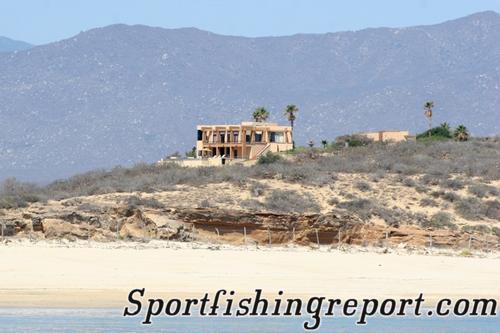
Sweet Fishing Under Lion???s Head
5-26-2009
Bill Roecker
Three and a half days of fishing at John Ireland's Rancho Leonero split partner Paul Sweeney and I on two marlin boats, so we could shoot "boat-to-boat," as they say in the industry. Paul went with Jack Nilsen on Mark Raynor's Jen Wren, while I went with Ireland aboard his Maton.
We saw a few jumpers, and got a marlin the first day, a nice 130-pounder by my estimation. Gary Tubbs of Escondido played it to release. Nilsen got a sailfish. The marlin took a trolled jig, and the sailfish came on a drop back bait for Jack, who was field-testing his new line of super-strong small reels, which he calls the B2X or Extreme series, with 400, 500 and 600 models.
"The 600 series would be similar to the old 6/0 size," said Jack. "It's like the 665."
The other reel numbers are scaled down accordingly, and closely match the 870 and the 270 Accurates. Jack was also using his new line of rods and his AccuBraid backing.
"We enjoyed casting to billfish on the 7040 Accurate Xtreme matched to the new B2 Xtreme 500, loaded with 60-pound AcccuBraid," said Nilsen. "We had excellent opportunities on billfish???we hooked maybe one of eight we cast to, but that's the way fishing is. It's a challenge to cast live bait to these fish with the outriggers and all the other gear out.
"It was a joy to handle these light rigs. We had to cast over the outriggers, and it was very effective with the lighter gear.
"We spotted a lot of finning fish with gyroscopic binoculars. I think getting four to the boat was just fine. Our main action was on the live bait after they approached the spread."
East Cape's weather was fine on all days, with a pattern of south in the late morn, coming around to east or north for a short period in the afternoon, before settling to a soft breeze from the south again. Each day clouds built over the local mountains, trying to become thunderheads before they spread out to disperse. Air temperature got into the 90's in the daytime. Sea temps varied in the mid-70's.
That first night it rained lightly before dawn, not usual. It sure made the countryside smell great, though.
On our second day we lost radio contact with Jen Wren before we got our sardine baits from the local panga men selling it. Tubbs and I elected to fish inside, as we were without Ireland for the day and Gary wanted to try for a roosterfish. He already had his first marlin.
We fished hard, flylining sardinas for a variety of yellowtail snapper (Pargo Amarillo), cabrilla, sierra, roosterfish, barred pargo and a few pesky trumpet fish. We fished on both sides of Rancho Leonero that day, and found the best concentration of roosterfish just off the boat garage at Buena Vista. We released six or eight pez gallo.
"We got four marlin!" said Paul when he came in late that afternoon, happy about the footage and the stills he'd shot with Nilsen's party. That many should have been plenty for testing new rigs by Jack Nilsen.
Paul told us about making bonito for bait and using tubes to keep them alive. We sat on stools *with Tubbs at the Rancho Leonero bar, improved some but basically unchanged, like the rest of the resort. We looked out at the coconut palm trees, the white beach and the boats bobbing, moored out in blue water. The boys enjoyed cold Pacificos, tortilla chips and fresh ceviche made for us by the cooks and bartender, from a fish I caught earlier that day.
I was pleased we'd taken the trouble to head, gut and ice that sierra mackerel. If you've never tried fresh sierra as ceviche, it may be useless trying to explain how good it is. Let's just say it's special stuff, and the resort did a fine job with it.
The boys hadn't eaten ceviche before. They ate the whole bowlful, then went out to the veranda for sunset dinner overlooking the calming Sea of Cortez. During the red into blue dusk we had a choice of fish, beef or chicken tacos, with all the fixings and side dishes, flan for desert. All meals on this veranda are memorable, but the sunset dinners there can't be matched.
We slept on brand new Serta mattresses on the second floor of the newest addition, at the front of the hotel. The bathrooms here are even larger than the super-size unit in the rest of the resort, and they're walled off to the thatch roof for privacy. The air conditioning worked flawlessly, near silent. There was plenty of clean, fresh water from the aquifer coming out of the nearby rugged peaks.
Our third day of fishing found Paul aboard the Maton with Gary Tubbs and myself. Captain Ireland was at the wheel, and the breeze was down. The sea was almost flat, with the trace of a wrap-around Pacific swell and a slight ruffle over half the surface.
The breeze was down, and so were the marlin. Where many jumpers had been seen the day before, now there were none. No finners, either. It was an hour or more before we saw a fish up. It sank out as we approached. We threw live bait on a feeder that was slashing the surface, and it refused the offering of a lively green jack.
Around midday we saw a couple of jumpers in the distance. We trolled and watched and waited and watched. We saw only one other fish being fought on a dozen other boats.
"There's a big dorado!" shouted Ireland from his perch over the cockpit of the Maton.
We could see the tip of the tail and parts of the dorsal fin sticking out of the water as the Maton approached from an angle to pull the jigs in front of the fish. Deckhand-skipper Gambino lobbed out another fresh jack.
No deal. The dorado sank out. We covered the near area a couple of times with the jigs, and saw no more of the dorado.
Sitting up on the Shamrock's flying bridge with the skipper, I asked John Ireland about roosterfishing on the Ranch.
"I've been here since 1982," he recalled. "In 1983 I was shoveling sand, when I saw my first roosterfish. A kid walked by with one that was still flopping. There were more kids on the beach, grabbing stranded roosterfish, big 50 and 60-pounders!
"Those roosters were chasing bait right up onto the beach, and some of them were stranding themselves. They have absolutely no fear. And that's how I learned about roosterfish. I didn't even know they were here until then."
Many minutes later, returning from a foray toward the south, we saw the dorado again, going along in the same direction with its tail and fin out, when we returned to our original position. This time it took a bait.
Gary Tubbs, 29 and fresh from his first marlin and first roosterfish, was now on the biggest dorado of his life. It made numerous jumps, flipping and cartwheeling and porpoising over the surface, and finally placing itself in that stubborn, planerboard position that bull dolphin seem to instinctively know, forcing Tubbs to pull against the whole flat side of the fish.
The strength of the angler and the heft of the gear prevailed in the end, and the bull dorado arrived shining and golden at the Maton's portside aft. Many pictures were taken of the fish in the water and displayed on deck. It was too big to go into the fish box below deck.
Ireland and Gambino were joyous. Tubbs was stoked. We headed toward shore and looked for roosterfish on the way home. When we got to the movable pier, boat manager Paco came out and took photos of Tubbs with his fish for the resort wall of fame, temporary and monthly.
Two special dinners were enjoyed at the nearby homes of ranch foreman Gary Barnes-Webb and owner John Ireland. Gary's place is the famous round house to the north of the ranch, a stout red-roofed concrete place he told me he'd built himself, out of pocket, a piece at a time. His wife Jeanine put on a buffet and the guests enjoyed his porch and the roundhouse view overlooking the beach.
We also dinner-partied right under the Lion's Head (flat-topped promontory, the local landmark) with Ireland and his wife Jennifer. We dined at the impressive digs John built over many years, out on the end of the ridge that terminates a quarter-mile north at the hotel. In between are the Riviera-style summer homes that spring up yearly along the bluff and beach. Both of these incredible homes (Ireland's and Barnes-Webb's) feature spas and pools that overlook the view and seem to drop off at that edge.
The water in Ireland's pool is a magnet for the local bird life. Cardinals, orioles, threshers, whitewing doves, Inca doves and even honeybees come to the shallow edge of the drop off to drink. Ospreys and caracaras soar past during the day and in the evening nighthawks and bats pick off insects in the lights above the life-giving water.
I asked John what he'd been doing lately at the Ranch.
"You know about the new beds," he said in his soft-spoken way.
"Oh, yeah!" I replied. "We've been sleeping very well on those nice new big Serta beds."
"Well, we've got a new laundry room, and we've rebuilt the kitchen. There's new tile in the bar, and we've re-powered the pangas and cruisers. And we're refinishing the cruisers."
"I saw two cruisers down by your old place with a fresh finish on them," I said. "They looked really good, like new."
We were scheduled to leave on Friday. After he got his boats out that morning, Gary Barnes-Webb took Paul and I out on a quick beach fishing trip. I've done this last-day trip with him a couple of times, and nearly had to miss my plane when Gary hooked up on a blue marlin once, and on an 80-pound roosterfish on another occasion.
On this fine warm East Cape morning Gary took us out on quads, down the beach south to the estuary outlet, where he used a cast net to make two live mullet for bait. One mullet went out with a sinker right away. I manned that rod while Gary stalked the schools to make a second throw. A big needle ate the bait, and after I set the hook and began to pull on it, the needlefish leaped and bit through the line.
Gary got a half-dozen mullet with his next cast. He put the baits in a bucket with a lid, and we headed back up the beach, looking for fish. We were short on time. I hooked another needlefish, a four-footer, briefly on the sinker rig, before it threw the hook, leaping like a marlin and shaking its head.
Gary threw a bait on a jack cruising past, but it just headed out to sea.
"I got too close," he said.
We didn't care. This is a fun way to fish! I've always loved sight-fishing, and this is something I'd like to do again.
An osprey was fishing for mullet alongside us. When it got a mullet, the fish eagle sat on a nearby snag to eat it, and Paul was able to approach the bird for some close pictures. Schools of mullet, halfbeaks or sardinas showered out and back into the surface not far away, but we didn't see the roosterfish chasing them. The predators might also have been jack crevalle, which can be even thicker than the roosters at times.
But it was time to leave the white shell-sand beaches of Rancho Leonero, and the beautiful sea that turns from light green to deep blue as you look out from shore. We went back to pack, get a last swim in the pool and enjoy lunch on the veranda in the sea breeze, watching pelicans and frigate birds glide by. We soaked up those last moments watching the palms sway, hearing the waves lapping below, and looking out at the little white wavelets blinking on the blue water.
Afterthought
Many people haven't been going to Mexico since the first flu warnings went out. Business is down there, and the people of Baja are suffering because of it. It should be known that there have been no cases of swine flu in Baja. None.
There have been about 5,000 in southern California, however. John Ireland thinks the constant harping by the American press on the drug problems in the border cities also keeps people away from East Cape and Rancho Leonero. That would seem like silliness to me. You're safer here than you are in LA, I'm sure. And the fishing, the view and relaxation are much better. Here's how to get in on some of it:
Rancho Leonero Connections:
www.rancholeonero.com (760) 438-2905 (800) 646-2252
We saw a few jumpers, and got a marlin the first day, a nice 130-pounder by my estimation. Gary Tubbs of Escondido played it to release. Nilsen got a sailfish. The marlin took a trolled jig, and the sailfish came on a drop back bait for Jack, who was field-testing his new line of super-strong small reels, which he calls the B2X or Extreme series, with 400, 500 and 600 models.
"The 600 series would be similar to the old 6/0 size," said Jack. "It's like the 665."
The other reel numbers are scaled down accordingly, and closely match the 870 and the 270 Accurates. Jack was also using his new line of rods and his AccuBraid backing.
"We enjoyed casting to billfish on the 7040 Accurate Xtreme matched to the new B2 Xtreme 500, loaded with 60-pound AcccuBraid," said Nilsen. "We had excellent opportunities on billfish???we hooked maybe one of eight we cast to, but that's the way fishing is. It's a challenge to cast live bait to these fish with the outriggers and all the other gear out.
"It was a joy to handle these light rigs. We had to cast over the outriggers, and it was very effective with the lighter gear.
"We spotted a lot of finning fish with gyroscopic binoculars. I think getting four to the boat was just fine. Our main action was on the live bait after they approached the spread."
East Cape's weather was fine on all days, with a pattern of south in the late morn, coming around to east or north for a short period in the afternoon, before settling to a soft breeze from the south again. Each day clouds built over the local mountains, trying to become thunderheads before they spread out to disperse. Air temperature got into the 90's in the daytime. Sea temps varied in the mid-70's.
That first night it rained lightly before dawn, not usual. It sure made the countryside smell great, though.
On our second day we lost radio contact with Jen Wren before we got our sardine baits from the local panga men selling it. Tubbs and I elected to fish inside, as we were without Ireland for the day and Gary wanted to try for a roosterfish. He already had his first marlin.
We fished hard, flylining sardinas for a variety of yellowtail snapper (Pargo Amarillo), cabrilla, sierra, roosterfish, barred pargo and a few pesky trumpet fish. We fished on both sides of Rancho Leonero that day, and found the best concentration of roosterfish just off the boat garage at Buena Vista. We released six or eight pez gallo.
"We got four marlin!" said Paul when he came in late that afternoon, happy about the footage and the stills he'd shot with Nilsen's party. That many should have been plenty for testing new rigs by Jack Nilsen.
Paul told us about making bonito for bait and using tubes to keep them alive. We sat on stools *with Tubbs at the Rancho Leonero bar, improved some but basically unchanged, like the rest of the resort. We looked out at the coconut palm trees, the white beach and the boats bobbing, moored out in blue water. The boys enjoyed cold Pacificos, tortilla chips and fresh ceviche made for us by the cooks and bartender, from a fish I caught earlier that day.
I was pleased we'd taken the trouble to head, gut and ice that sierra mackerel. If you've never tried fresh sierra as ceviche, it may be useless trying to explain how good it is. Let's just say it's special stuff, and the resort did a fine job with it.
The boys hadn't eaten ceviche before. They ate the whole bowlful, then went out to the veranda for sunset dinner overlooking the calming Sea of Cortez. During the red into blue dusk we had a choice of fish, beef or chicken tacos, with all the fixings and side dishes, flan for desert. All meals on this veranda are memorable, but the sunset dinners there can't be matched.
We slept on brand new Serta mattresses on the second floor of the newest addition, at the front of the hotel. The bathrooms here are even larger than the super-size unit in the rest of the resort, and they're walled off to the thatch roof for privacy. The air conditioning worked flawlessly, near silent. There was plenty of clean, fresh water from the aquifer coming out of the nearby rugged peaks.
Our third day of fishing found Paul aboard the Maton with Gary Tubbs and myself. Captain Ireland was at the wheel, and the breeze was down. The sea was almost flat, with the trace of a wrap-around Pacific swell and a slight ruffle over half the surface.
The breeze was down, and so were the marlin. Where many jumpers had been seen the day before, now there were none. No finners, either. It was an hour or more before we saw a fish up. It sank out as we approached. We threw live bait on a feeder that was slashing the surface, and it refused the offering of a lively green jack.
Around midday we saw a couple of jumpers in the distance. We trolled and watched and waited and watched. We saw only one other fish being fought on a dozen other boats.
"There's a big dorado!" shouted Ireland from his perch over the cockpit of the Maton.
We could see the tip of the tail and parts of the dorsal fin sticking out of the water as the Maton approached from an angle to pull the jigs in front of the fish. Deckhand-skipper Gambino lobbed out another fresh jack.
No deal. The dorado sank out. We covered the near area a couple of times with the jigs, and saw no more of the dorado.
Sitting up on the Shamrock's flying bridge with the skipper, I asked John Ireland about roosterfishing on the Ranch.
"I've been here since 1982," he recalled. "In 1983 I was shoveling sand, when I saw my first roosterfish. A kid walked by with one that was still flopping. There were more kids on the beach, grabbing stranded roosterfish, big 50 and 60-pounders!
"Those roosters were chasing bait right up onto the beach, and some of them were stranding themselves. They have absolutely no fear. And that's how I learned about roosterfish. I didn't even know they were here until then."
Many minutes later, returning from a foray toward the south, we saw the dorado again, going along in the same direction with its tail and fin out, when we returned to our original position. This time it took a bait.
Gary Tubbs, 29 and fresh from his first marlin and first roosterfish, was now on the biggest dorado of his life. It made numerous jumps, flipping and cartwheeling and porpoising over the surface, and finally placing itself in that stubborn, planerboard position that bull dolphin seem to instinctively know, forcing Tubbs to pull against the whole flat side of the fish.
The strength of the angler and the heft of the gear prevailed in the end, and the bull dorado arrived shining and golden at the Maton's portside aft. Many pictures were taken of the fish in the water and displayed on deck. It was too big to go into the fish box below deck.
Ireland and Gambino were joyous. Tubbs was stoked. We headed toward shore and looked for roosterfish on the way home. When we got to the movable pier, boat manager Paco came out and took photos of Tubbs with his fish for the resort wall of fame, temporary and monthly.
Two special dinners were enjoyed at the nearby homes of ranch foreman Gary Barnes-Webb and owner John Ireland. Gary's place is the famous round house to the north of the ranch, a stout red-roofed concrete place he told me he'd built himself, out of pocket, a piece at a time. His wife Jeanine put on a buffet and the guests enjoyed his porch and the roundhouse view overlooking the beach.
We also dinner-partied right under the Lion's Head (flat-topped promontory, the local landmark) with Ireland and his wife Jennifer. We dined at the impressive digs John built over many years, out on the end of the ridge that terminates a quarter-mile north at the hotel. In between are the Riviera-style summer homes that spring up yearly along the bluff and beach. Both of these incredible homes (Ireland's and Barnes-Webb's) feature spas and pools that overlook the view and seem to drop off at that edge.
The water in Ireland's pool is a magnet for the local bird life. Cardinals, orioles, threshers, whitewing doves, Inca doves and even honeybees come to the shallow edge of the drop off to drink. Ospreys and caracaras soar past during the day and in the evening nighthawks and bats pick off insects in the lights above the life-giving water.
I asked John what he'd been doing lately at the Ranch.
"You know about the new beds," he said in his soft-spoken way.
"Oh, yeah!" I replied. "We've been sleeping very well on those nice new big Serta beds."
"Well, we've got a new laundry room, and we've rebuilt the kitchen. There's new tile in the bar, and we've re-powered the pangas and cruisers. And we're refinishing the cruisers."
"I saw two cruisers down by your old place with a fresh finish on them," I said. "They looked really good, like new."
We were scheduled to leave on Friday. After he got his boats out that morning, Gary Barnes-Webb took Paul and I out on a quick beach fishing trip. I've done this last-day trip with him a couple of times, and nearly had to miss my plane when Gary hooked up on a blue marlin once, and on an 80-pound roosterfish on another occasion.
On this fine warm East Cape morning Gary took us out on quads, down the beach south to the estuary outlet, where he used a cast net to make two live mullet for bait. One mullet went out with a sinker right away. I manned that rod while Gary stalked the schools to make a second throw. A big needle ate the bait, and after I set the hook and began to pull on it, the needlefish leaped and bit through the line.
Gary got a half-dozen mullet with his next cast. He put the baits in a bucket with a lid, and we headed back up the beach, looking for fish. We were short on time. I hooked another needlefish, a four-footer, briefly on the sinker rig, before it threw the hook, leaping like a marlin and shaking its head.
Gary threw a bait on a jack cruising past, but it just headed out to sea.
"I got too close," he said.
We didn't care. This is a fun way to fish! I've always loved sight-fishing, and this is something I'd like to do again.
An osprey was fishing for mullet alongside us. When it got a mullet, the fish eagle sat on a nearby snag to eat it, and Paul was able to approach the bird for some close pictures. Schools of mullet, halfbeaks or sardinas showered out and back into the surface not far away, but we didn't see the roosterfish chasing them. The predators might also have been jack crevalle, which can be even thicker than the roosters at times.
But it was time to leave the white shell-sand beaches of Rancho Leonero, and the beautiful sea that turns from light green to deep blue as you look out from shore. We went back to pack, get a last swim in the pool and enjoy lunch on the veranda in the sea breeze, watching pelicans and frigate birds glide by. We soaked up those last moments watching the palms sway, hearing the waves lapping below, and looking out at the little white wavelets blinking on the blue water.
Afterthought
Many people haven't been going to Mexico since the first flu warnings went out. Business is down there, and the people of Baja are suffering because of it. It should be known that there have been no cases of swine flu in Baja. None.
There have been about 5,000 in southern California, however. John Ireland thinks the constant harping by the American press on the drug problems in the border cities also keeps people away from East Cape and Rancho Leonero. That would seem like silliness to me. You're safer here than you are in LA, I'm sure. And the fishing, the view and relaxation are much better. Here's how to get in on some of it:
Rancho Leonero Connections:
www.rancholeonero.com (760) 438-2905 (800) 646-2252
Photos
< Previous Report Next Report >
More Reports

5-26-2009
Short Trips For Wahoo? "I always book 5-day trips but want to get a shot at Wahoo. In your opinion...... Read More
Fishing Videos Reports
for Monday, May 11th, 2009• Long Range Fishing: The Mix Can Amaze Beginners

LongRangeSportfishing.net © 2025. All Rights Reserved.
Website Hosting and Design provided by TECK.net
Website Hosting and Design provided by TECK.net
